Monolith
A monolith is a geological feature consisting of a single massive stone or rock, such as some mountains, or a single large piece of rock placed as, or within, a monument or building. Erosion usually exposes the geological formations, which are often made of very hard and solid igneous or metamorphic rock.

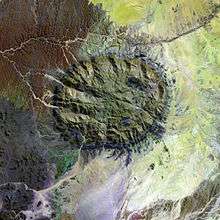
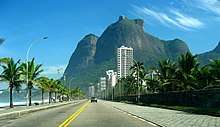
In architecture, the term has considerable overlap with megalith, which is normally used for prehistory, and may be used in the contexts of rock-cut architecture that remains attached to solid rock, as in monolithic church, or for exceptionally large stones such as obelisks, statues, monolithic columns or large architraves, that may have been moved a considerable distance after quarrying. It may also be used of large glacial erratics moved by natural forces.
The word derives, via the Latin monolithus, from the Ancient Greek word μονόλιθος (monolithos), from μόνος ("one" or "single") and λίθος ("stone").
Geological monoliths
Large, well-known monoliths include:
Africa
- Aso Rock, Nigeria
- Ben Amera, Mauritania
- Brandberg Mountain, Namibia
- Sibebe, Swaziland
- Zuma Rock, Nigeria
- Mount Lubiri, Angola
- Mount Poi, Kenya
- Great Sphinx of Giza
Antarctica
- Scullin monolith
Asia
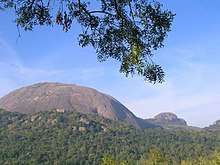
- Bellary, India
- Bhongir, Telangana, India
- Madhugiri Betta, Karnataka, India
- Kailasa temple, Ellora. Maharashtra, India
- Mount Kelam, Indonesia
- Mount Pico de Loro, Philippines
- Mount Pulumbato, Philippines
- Sangla Hill, Pakistan
- Savandurga, Karnataka, India
- Sigiriya, Sri Lanka
- Yana, Karnataka, India
- Gilbert Hill, Mumbai, India
Australia
- Bald Rock, near Tenterfield, New South Wales
- Mount Augustus (Burringurrah), Western Australia
- Mount Coolum, Queensland
- Mount Wudinna, South Australia
- Pine Mountain, Victoria
- Uluru, Northern Territory
Europe
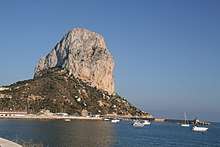
- Kalamos, Anafi, Greece
- Katskhi pillar, Georgia
- Logan Rock, Treen, Cornwall, England
- Penyal d'Ifac, Calpe, Valencian Community, Spain
- La Peña de Arcos, Arcos de la Frontera, Andalusia, Spain
- Peña de los Enamorados, Antequera, Andalusia, Spain (a World Heritage Site)
- Rock of Gibraltar, Gibraltar
- Rock of Monaco, Monaco-Ville, Monaco
- Rock Cappa, San Luca, Italy
North America
United States
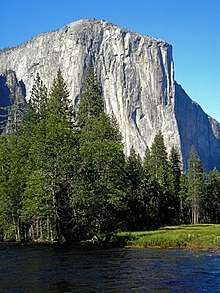
- Angels Landing, Zion National Park, Utah
- Beacon Rock, Columbia River Gorge, Washington
- Bottleneck Peak and Moon, Sids Mountain, Utah
- Castle Rock, Pineville, West Virginia
- Chimney Rock, Bayard, Nebraska
- Chimney Rock, Chimney Rock, North Carolina
- Courthouse and Jail Rocks, Bridgeport, Nebraska
- Devils Tower, Wyoming
- El Capitan, Yosemite National Park, California
- Enchanted Rock, Llano County, Texas
- Frog Woman Rock, Mendocino County, California
- Great White Throne, Zion National Park, Utah
- Half Dome, Yosemite National Park, California
- Haystack Rock, Clatsop County, Oregon
- Looking Glass Rock, Transylvania County, North Carolina
- Morro Rock, Morro Bay, California
- Scotts Bluff National Monument, Gering, Nebraska
- Shiprock, San Juan County, New Mexico
- Stone Mountain, Stone Mountain, Georgia
- Tooth of Time, Cimarron, New Mexico
- Wolf Rock, Linn County, Oregon
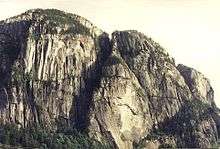
Canada
- Stawamus Chief, Squamish, British Columbia
South America
- El Peñón, also known as El Peñol Stone or simply La Piedra, Colombia
- Pão de Açúcar, Brazil
- Pedra da Gávea, Brazil the world's largest monolith on the coastline
- Pedra da Galinha Choca, Brazil
- Torres del Paine, Chile
Extraterrestrial
- Phobos monolith on Phobos
- Mars monolith
Monumental monoliths
A structure which has been excavated as a unit from a surrounding matrix or outcropping of rock.[5]
- Aztec calendar stone "Stone of the Sun"
- The Church of Saint George in Lalibela, Ethiopia, is one of a number of monolithic churches in Ethiopia
- Coyolxauhqui Stone another aztec monolith
- Ellora Caves - UNESCO World Heritage Site
- Great Sphinx of Giza "The Egyptian Sphinx"
- Gomateswara or Lord Bahubali at Sravanabelagola, Karnataka
- Manzanar National Historic Landmark, USA
- Obelisks - see this article for a list
- Ogham stones, inscribed standing stones throughout Ireland
- Runestones
- Standing stones
- Stelae
- Stone circle
- Stone of the Pregnant Woman, Baalbek
- Stonehenge contains several
- The Longstones or the Devil's Quoits, Avebury, Wiltshire, England
- Vijayanagara Empire medieval South Indian carved examples
See also
References
- López Domínguez, Leonor (May 2001). "Villa de Bernal and its Magic Mountain". México Desconocido #291. Archived from the original on 2015-03-13.
- "Peña de Bernal - Bernal - Queretaro" (in Spanish). Archived from the original on 27 October 2006. Retrieved 25 November 2008.
- Raul Carrillo (2007). Northrop, Laura Cava; Dwight L. Curtis; Natalie Sherman (eds.). Let's Go Mexico: On a Budget. Macmillan. p. 370. ISBN 978-0-312-37452-5.
- Escobar Ledesma, Agustín (1999). Recetario del semidesierto de Querétaro: Acoyos, rejalgares y tantarrias. Conaculta. p. 75. ISBN 978-970-18-3910-2.
- "Glossary". Archived from the original on 2010-01-01.
External links
| Wikimedia Commons has media related to Monoliths. |
- Regarding Uluru/Ayers Rock and earlier representations of it as the largest monolith: GA.gov.au, ABC.net.au, Wayoutback.com.au
